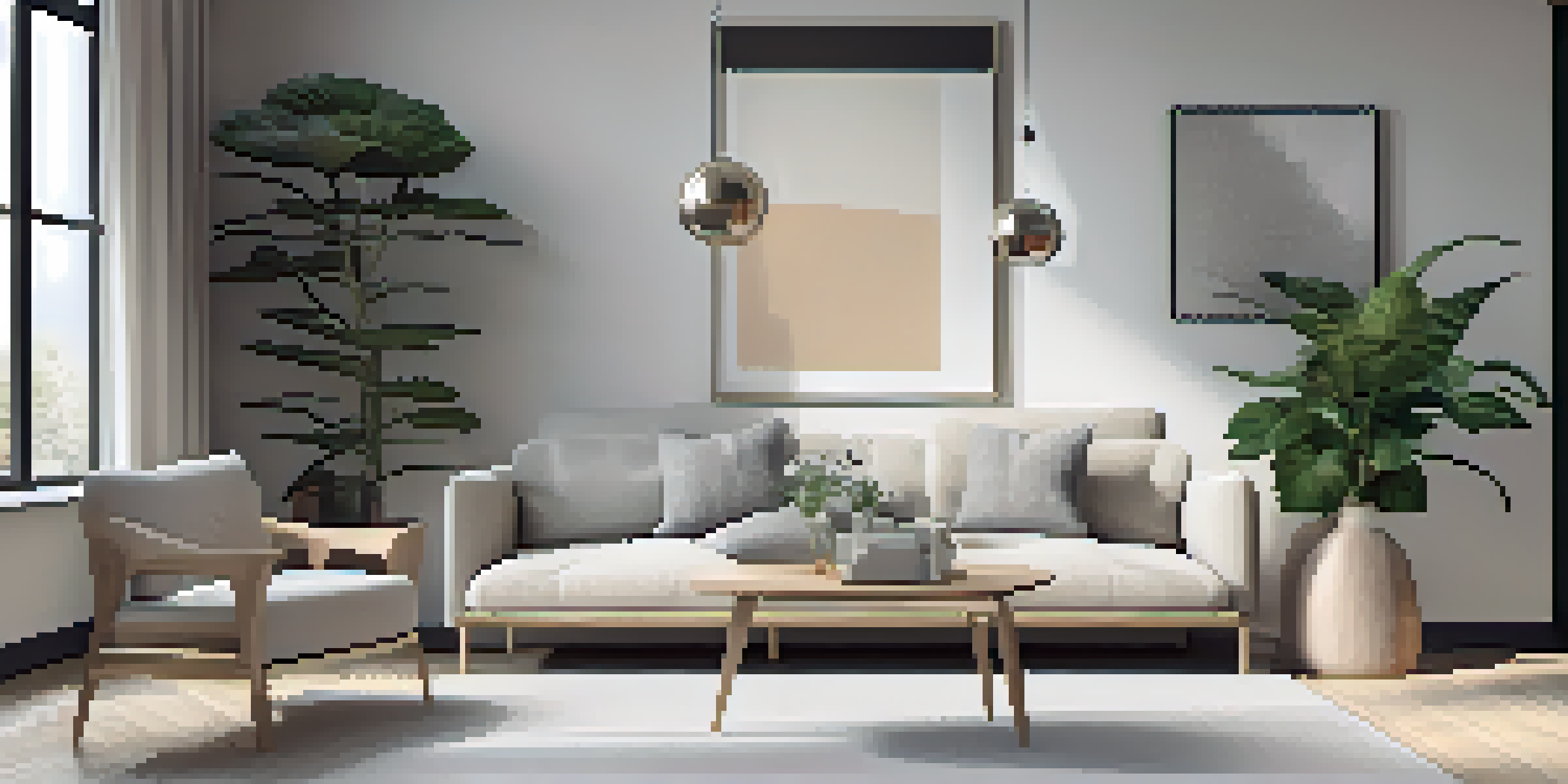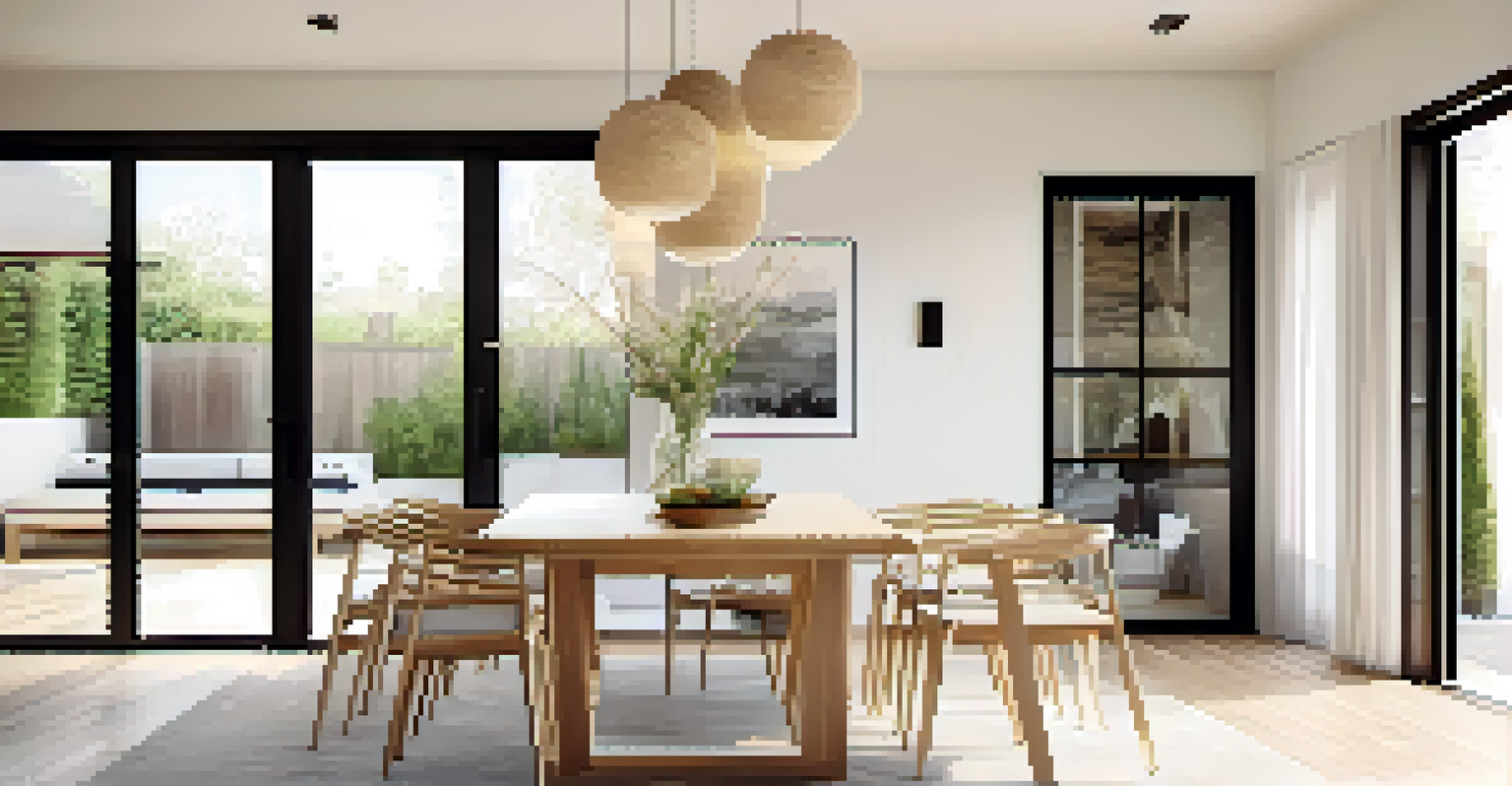The Art of Minimalism in Small Home Design

Understanding Minimalism in Home Design
Minimalism is more than just a design trend; it's a lifestyle choice that focuses on simplicity and functionality. In home design, it encourages homeowners to strip away excess clutter and unnecessary items, allowing the space to breathe. This approach can be especially beneficial in small homes where every square foot counts. By prioritizing essential elements, minimalism creates a serene and inviting atmosphere.
The ability to simplify means to eliminate the unnecessary so that the necessary may speak.
At its core, minimalism promotes the idea that less is more. When you eliminate distractions and focus on the essentials, you can create spaces that are both beautiful and practical. For example, a single statement piece of furniture can serve as a focal point in a room, drawing the eye and creating a sense of balance. This is particularly effective in small areas, where overcrowding can quickly overwhelm the senses.
Moreover, minimalism encourages intentionality in design choices. Each item in a minimal space should serve a purpose, contributing to the overall aesthetic and functionality of the home. This means selecting high-quality, versatile pieces that can adapt to various needs over time, making your small space not just stylish but also highly functional.
Maximizing Space with Minimalist Principles
Small homes often come with unique challenges, but minimalist design principles can help maximize the available space. One effective strategy is to use multifunctional furniture, such as a sofa bed or a coffee table with storage capabilities. These pieces not only save space but also reduce clutter by serving multiple purposes, allowing you to enjoy a more open and airy environment.

Another important aspect of minimalist design is the clever use of vertical space. By incorporating shelves and cabinets that draw the eye upward, you can create the illusion of higher ceilings and a more spacious feel. Think about wall-mounted shelving for books or decorative items, which can free up valuable floor space while adding visual interest to the room.
Additionally, consider the layout of your small home. An open-concept design can enhance the flow between rooms, making the space feel larger and more cohesive. By removing unnecessary walls and barriers, you can create a seamless transition from one area to another, promoting a sense of unity and spaciousness.
Choosing a Neutral Color Palette for Small Spaces
Color plays a significant role in how we perceive space, and a neutral palette is a hallmark of minimalist design. Soft tones like whites, beiges, and light grays can make a small home feel more expansive and inviting. These colors reflect light, creating an open atmosphere that can help combat feelings of confinement often found in smaller areas.
Minimalism is not a lack of something. It’s simply the perfect amount of something.
In addition to making the space feel larger, neutral colors provide a versatile backdrop for your decor. You can easily add pops of color through accessories like cushions, artwork, or plants, allowing for personal expression without overwhelming the space. This approach maintains the minimalist ethos while still allowing for creativity.
Moreover, using a cohesive color scheme throughout your home can enhance the sense of flow and continuity. When each room shares a similar palette, it creates a harmonious environment that feels more connected. This can be especially important in small homes, where visual clutter can quickly become a distraction.
The Importance of Decluttering in Minimalism
Decluttering is a fundamental practice in minimalist design, serving as a crucial step in creating a peaceful living environment. The process involves assessing your belongings and determining what is truly necessary, which can be both liberating and rewarding. By letting go of items that no longer serve a purpose or bring joy, you pave the way for a clean and organized space.
One effective method for decluttering is the 'one in, one out' rule: for every new item you bring into your home, consider removing an existing one. This practice not only helps maintain order but also encourages thoughtful purchasing habits. Over time, this can lead to a more intentional collection of belongings that align with your minimalist lifestyle.
Additionally, regular decluttering sessions can help prevent the accumulation of clutter over time. Set aside time each month to evaluate your space and remove items that no longer fit your needs. This proactive approach ensures that your small home remains a sanctuary of simplicity and calm.
Incorporating Nature into Minimalist Design
Bringing nature indoors is an integral part of minimalist design, as it enhances the overall ambiance of your home. Plants can add life and color to a space while promoting a sense of tranquility. In small homes, choose low-maintenance plants that don't require extensive care, such as succulents or snake plants, which can thrive in limited light and space.
In addition to plants, consider using natural materials in your design. Wood, stone, and textiles can create a warm and inviting atmosphere that complements the minimalist aesthetic. For example, a wooden coffee table or stone accents can provide texture and warmth, making your small home feel cozy and comfortable.
Moreover, large windows or strategically placed mirrors can help establish a connection with the outdoors, enhancing the feeling of spaciousness. Allowing natural light to flood your home not only brightens the space but also creates a sense of openness that is essential in minimalist design.
The Role of Lighting in Small Home Design
Lighting is a crucial element in any home, but it takes on even greater importance in small spaces. Proper lighting can create a sense of depth and dimension, making your home feel larger and more inviting. Consider using a mix of ambient, task, and accent lighting to achieve a balanced and functional illumination throughout your space.
In addition to functionality, the right lighting can enhance the aesthetic appeal of your minimalist home. Pendant lights, floor lamps, and wall sconces can serve as striking design elements, drawing attention and adding personality to your space. Select fixtures that align with your overall design theme, ensuring they complement rather than overwhelm the minimalist ethos.
Finally, make the most of natural light by keeping window treatments simple and unobtrusive. Sheer curtains or blinds can allow light to filter through while maintaining privacy. This approach not only brightens your home but also connects the indoor and outdoor spaces, further enhancing the feeling of openness.
Conclusion: Embracing Minimalism for a Better Life
Embracing minimalism in small home design can lead to a more fulfilling and balanced lifestyle. By focusing on simplicity and functionality, you can create a space that nurtures your well-being and supports your daily activities. This intentional approach to design not only enhances your living environment but also encourages mindfulness in your choices and habits.
As you declutter, choose a neutral palette, and incorporate natural elements, you’ll discover the beauty in a well-curated space. Each decision you make can reflect your values and priorities, resulting in a home that truly feels like a sanctuary. Minimalism is not about deprivation; it's about making room for what matters most.

Ultimately, the art of minimalism is about finding joy in simplicity. By applying these principles to your small home design, you can create a peaceful retreat that fosters creativity, relaxation, and connection. So, take a step back, re-evaluate your space, and embrace the beauty of minimalism.